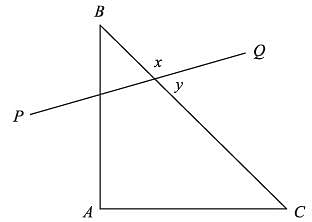ACT Exam > ACT Questions > In the figure below, triangle ABC is a ...
Start Learning for Free
In the figure below, triangle ABC is a 30–60–90 right triangle. If angle x measures 125◦ , what is the measure of angle y?


- a)35◦
- b)45◦
- c)55◦
- d)70◦
- e)90◦
Correct answer is option 'C'. Can you explain this answer?
Most Upvoted Answer
In the figure below, triangle ABC is a 30–60–90 righ...
The correct answer is c. Angles x and y are supplementary angles, so their sum is 180◦ . Angle x is given as 125◦ , so angle y is 180◦ − 125◦ = 55◦ .

|
Explore Courses for ACT exam
|

|
Similar ACT Doubts
In the figure below, triangle ABC is a 30–60–90 right triangle. If angle x measures 125 , what is the measure of angle y?a)35b)45c)55d)70e)90Correct answer is option 'C'. Can you explain this answer?
Question Description
In the figure below, triangle ABC is a 30–60–90 right triangle. If angle x measures 125 , what is the measure of angle y?a)35b)45c)55d)70e)90Correct answer is option 'C'. Can you explain this answer? for ACT 2025 is part of ACT preparation. The Question and answers have been prepared according to the ACT exam syllabus. Information about In the figure below, triangle ABC is a 30–60–90 right triangle. If angle x measures 125 , what is the measure of angle y?a)35b)45c)55d)70e)90Correct answer is option 'C'. Can you explain this answer? covers all topics & solutions for ACT 2025 Exam. Find important definitions, questions, meanings, examples, exercises and tests below for In the figure below, triangle ABC is a 30–60–90 right triangle. If angle x measures 125 , what is the measure of angle y?a)35b)45c)55d)70e)90Correct answer is option 'C'. Can you explain this answer?.
In the figure below, triangle ABC is a 30–60–90 right triangle. If angle x measures 125 , what is the measure of angle y?a)35b)45c)55d)70e)90Correct answer is option 'C'. Can you explain this answer? for ACT 2025 is part of ACT preparation. The Question and answers have been prepared according to the ACT exam syllabus. Information about In the figure below, triangle ABC is a 30–60–90 right triangle. If angle x measures 125 , what is the measure of angle y?a)35b)45c)55d)70e)90Correct answer is option 'C'. Can you explain this answer? covers all topics & solutions for ACT 2025 Exam. Find important definitions, questions, meanings, examples, exercises and tests below for In the figure below, triangle ABC is a 30–60–90 right triangle. If angle x measures 125 , what is the measure of angle y?a)35b)45c)55d)70e)90Correct answer is option 'C'. Can you explain this answer?.
Solutions for In the figure below, triangle ABC is a 30–60–90 right triangle. If angle x measures 125 , what is the measure of angle y?a)35b)45c)55d)70e)90Correct answer is option 'C'. Can you explain this answer? in English & in Hindi are available as part of our courses for ACT.
Download more important topics, notes, lectures and mock test series for ACT Exam by signing up for free.
Here you can find the meaning of In the figure below, triangle ABC is a 30–60–90 right triangle. If angle x measures 125 , what is the measure of angle y?a)35b)45c)55d)70e)90Correct answer is option 'C'. Can you explain this answer? defined & explained in the simplest way possible. Besides giving the explanation of
In the figure below, triangle ABC is a 30–60–90 right triangle. If angle x measures 125 , what is the measure of angle y?a)35b)45c)55d)70e)90Correct answer is option 'C'. Can you explain this answer?, a detailed solution for In the figure below, triangle ABC is a 30–60–90 right triangle. If angle x measures 125 , what is the measure of angle y?a)35b)45c)55d)70e)90Correct answer is option 'C'. Can you explain this answer? has been provided alongside types of In the figure below, triangle ABC is a 30–60–90 right triangle. If angle x measures 125 , what is the measure of angle y?a)35b)45c)55d)70e)90Correct answer is option 'C'. Can you explain this answer? theory, EduRev gives you an
ample number of questions to practice In the figure below, triangle ABC is a 30–60–90 right triangle. If angle x measures 125 , what is the measure of angle y?a)35b)45c)55d)70e)90Correct answer is option 'C'. Can you explain this answer? tests, examples and also practice ACT tests.

|
Explore Courses for ACT exam
|

|
Signup for Free!
Signup to see your scores go up within 7 days! Learn & Practice with 1000+ FREE Notes, Videos & Tests.


























